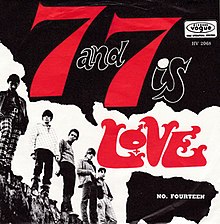7 and 7 Is
| "7 and 7 Is" | ||||
|---|---|---|---|---|
 | ||||
| Single by Love | ||||
| from the album Da Capo | ||||
| B-side | "No. Fourteen" | |||
| Released | July 1966 | |||
| Recorded |
| |||
| Genre | ||||
| Length | 2:15 | |||
| Label | Elektra | |||
| Songwriter(s) | Arthur Lee | |||
| Producer(s) | Jac Holzman | |||
| Love singles chronology | ||||
| ||||
"7 and 7 Is" is a song written by Arthur Lee and recorded by his band Love on June 17 & 20, 1966, at Sunset Sound Recorders in Hollywood.[3] It was produced by Jac Holzman and engineered by Bruce Botnick.
The song was released as the A-side of Elektra single 45605 in July, 1966. The B-side was "No. Fourteen", an outtake from the band's earlier recordings. "7 and 7 Is" made the Billboard Pop Singles chart on July 30, 1966, peaking at number 33 during a ten-week chart run and becoming the band's highest-charting hit single.[4] The recording also featured on the band's second album, Da Capo.
The song drew inspiration from a high school sweetheart of Lee, Anita "Pretty" Billings,[5] who shared his birthday, March 7. It also describes Lee's frustration at teenage life - the reference to "in my lonely room I'd sit, my mind in an ice cream cone" being to wearing (in reality or metaphorically) a dunce's cap.[6] Describing how the song came to him, Lee stated: "I was living on Sunset and woke up early one morning. The whole band was asleep. I went in the bathroom, and I wrote those words. My songs used to come to me just before dawn, I would hear them in dreams, but if I didn't get up and write them down, or if I didn't have a tape recorder to hum into, I was through. If I took for granted that I could remember it the next day—boink, it was gone."[7]
It took a great deal of work to record, with Love's drummer, Alban "Snoopy" Pfisterer, being challenged with its frantic demands after 30 takes or so, and being replaced on drums, intermittently, by Lee himself. In an interview for John Einarson's book Forever Changes (pg 117), lead guitarist Johnny Echols credits the drumming on the released record to Pfisterer. In a 1989 interview, Arthur Lee stated that he himself taught Pfisterer how to play the part, and that the final record featured Pfisterer. In what has been described as a "flirtation" with musique concrète,[8] the song climaxes in an apocalyptic explosion - the supposed sound of an atom bomb - before a peaceful conclusion, in a blues form, which then fades out.[6] Although many listeners thought that the explosion at the end of the song was a reverb unit being kicked or dropped, it was (according to the engineer Bruce Botnick in "Forever Changes" book, page 118), in actuality, taken from a sound effects record. He speculated that it was a recording of a gunshot slowed down. For live performances, the explosion was reproduced by kicking a reverb unit.
Music critic Robert Christgau called the song "a perfect rocker".[9]
Covers[]
Described as garage rock[1] and proto-punk,[2] the song was later covered by numerous bands, most notably the Ramones, Alice Cooper, The Electric Prunes, Billy Bragg, The Sidewinders, The Fuzztones, and Rush, as well as a re-recording by Lee himself. The song was also featured in the TV series Entourage in season 5 episode 1 during the closing credits.[10]
Former Chemlab vocalist Jared Louche covered "7 and 7 Is" with The Aliens for his 1999 solo debut Covergirl.[11]
Popular Culture[]
- The song was featured in Wes Anderson's first film, Bottle Rocket.
- This song is used in trailers for "The Dead Don't Die".[12]
- The song was also featured in the official reveal trailer for the Electronic Arts game Knockout City.[13]
References[]
- ^ Jump up to: a b Unterberger, Richie (2014). Jingle Jangle Morning: Folk-Rock in the 1960s. BookBaby. ISBN 978-0-9915892-1-0.
- ^ Jump up to: a b Schinder, S. & Schwartz, A. (2008). Icons of Rock. ABC-CLIO. p. 263. ISBN 9780313338465.
- ^ "Love - Da Capo". Discogs.com. Retrieved 25 April 2019.
- ^ Whitburn, Joel (2003). Top Pop Singles 1955-2002 (1st ed.). Menomonee Falls, Wisconsin: Record Research Inc. p. 424. ISBN 0-89820-155-1.
- ^ Steven Roby & Brad Schreiber, Becoming Jimi Hendrix: From Southern Crossroads to Psychedelic London, Da Capo Press, 2010, pp. 105-106
- ^ Jump up to: a b Barney Hoskyns, Arthur Lee: Alone Again Or, Mojo Books, 2001, ISBN 978-1-84195-085-3, pp.47-49
- ^ Gallo, Phil – Booklet included with Love Story 1966-1972, Rhino Records R2 73500 (1995), p. 15
- ^ Edwin Pouncey, "Rock Concrete", Undercurrents: The Hidden Wiring of Modern Music, Bloomsbury, 2002, p. 157
- ^ Christgau, R. (June 1967). "Columns". Esquire. Retrieved 2012-07-06.
- ^ "Informationen zum Thema songdetective". Songdetective.com. Retrieved 25 April 2019.
- ^ Steininger, Alex (July 30, 2020). "Jared Louche and the Aliens: Covergirl". In Music We Trust (26). Retrieved July 30, 2020.
- ^ Focus Features (2019-04-01), THE DEAD DON'T DIE - Official Trailer [HD] - In Theaters June 14, retrieved 2019-06-11
- ^ Knockout City: Official Reveal Trailer, 2021-02-17, retrieved 2021-07-12
- 1966 singles
- 1982 singles
- 1966 songs
- Songs written by Arthur Lee (musician)
- Love (band) songs
- Ramones songs
- Rush (band) songs
- Alice Cooper songs
- Song recordings produced by Jac Holzman
- Elektra Records singles
- American garage rock songs